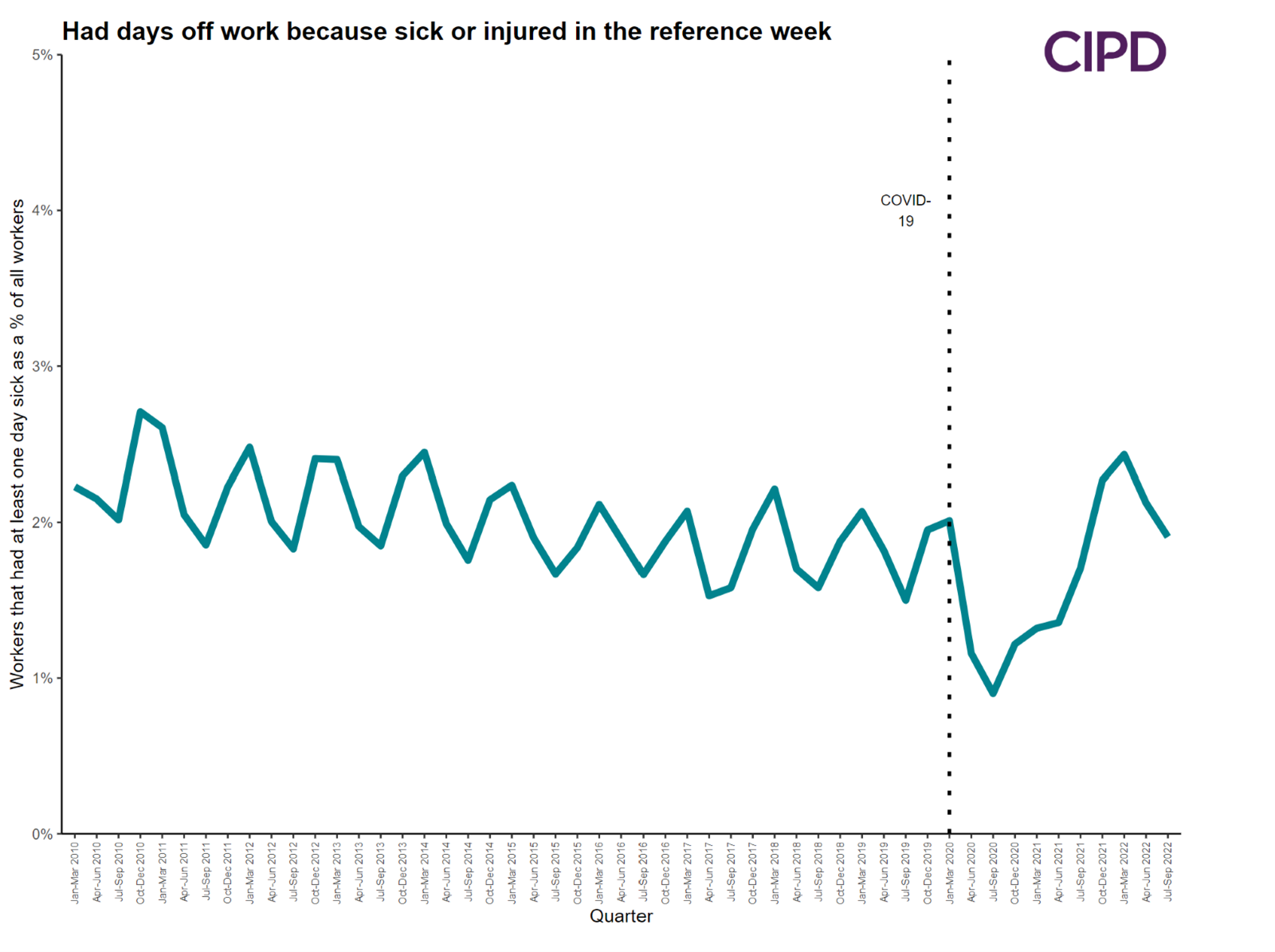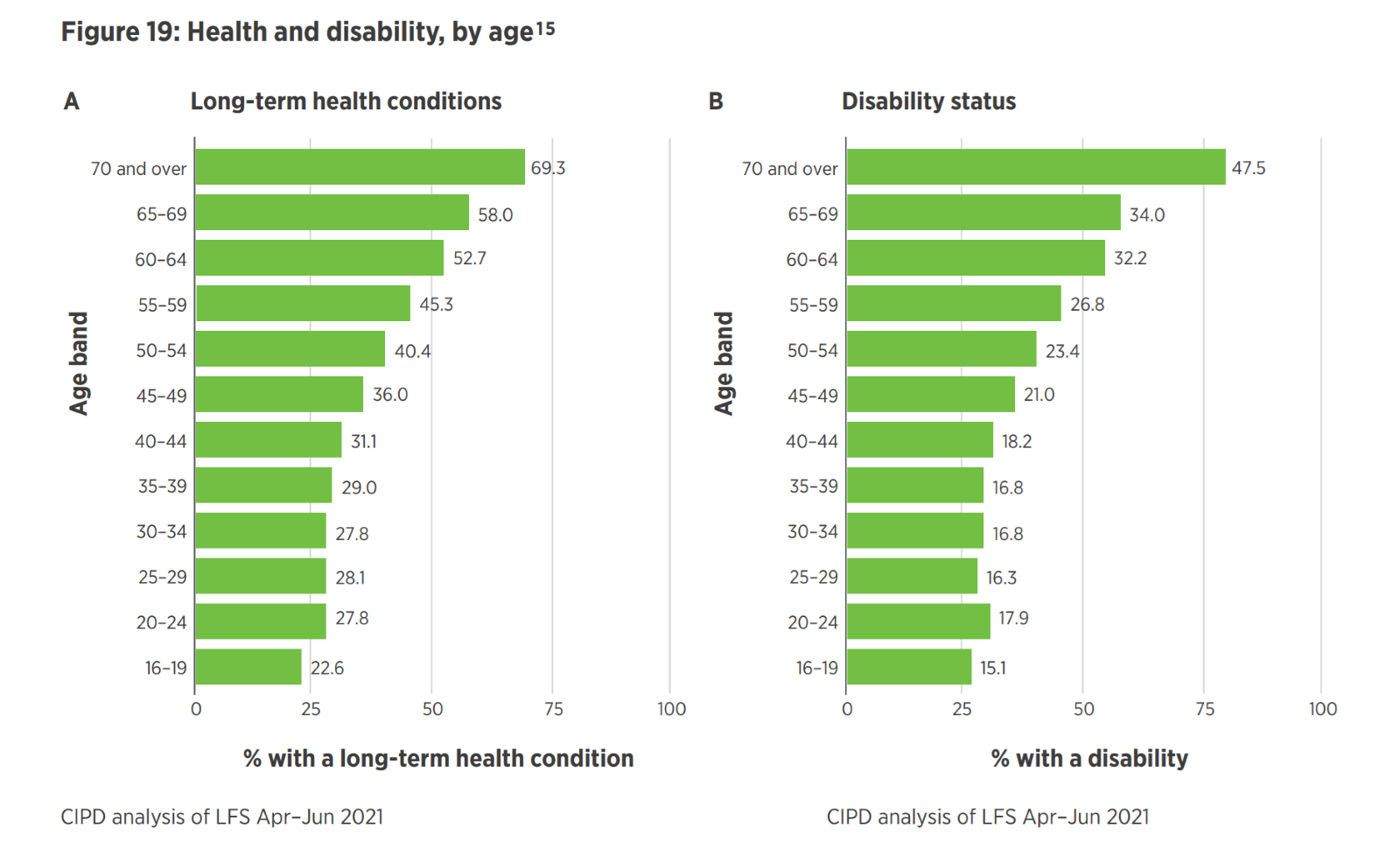This chart was created in February to look at sickness absence rates over time. The finding was stark. Sickness absence had been trending down for years, but had jumped up post-pandemic.
In April the ONS published an article confirming that sickness absence had increased bringing us back to levels last seen in 2004.

Perhaps more worrying than sickness absence from work is the rise in people inactive – that is not working nor seeking work – due to ill health. The May 2023 labour market statistic showed this category of inactivity to have reached record high levels.
Research by the IFS showed a rise in sickness in the population, across age groups and conditions. It showed that the number of new disability benefit claimants has doubled in a year. The research also looked at an objective measure of health, the number of deaths. It found that there has been a rise in the number of (non-COVID) working-age deaths from late 2021 through 2022, compared to pre-pandemic years.
Taken together, this growing body of evidence suggests that yes, the UK population is sicker than it was pre-pandemic. The consequences include more days off sick, and more people dropping out of work entirely.
What’s the cause?
It seems obvious that some of the increased sickness absence is due to COVID-19. The ONS estimate that COVID-19 caused 14% of sickness absence in 2020, and 24% of sickness absence in 2021. I estimate that COVID-19 caused 37% of sickness absences in the first six months of 2022 1. The specific question asked in the labour force survey is ‘Whether sickness absence is linked to coronavirus (COVID-19)’. This could include both COVID-19 the infection and long-COVID. Research from the Bank of England has also suggested that increased NHS waiting lists are also a factor in increased sickness. In addition, the ageing population can explain some of the increase in sickness as older age is associated with higher rates of long-term conditions 2 - chart below.

Source: CIPD report, Understanding older workers
Policy recommendations
Bank of England research (cited above) notes that ‘of the long-term sick, 3m (52%) were economically active (3.0m employed, 0.3m unemployed)’. The majority of long-term sick (of working age) are able to work. Allowing them to do so is key for employers and policymakers. Increased sickness and a smaller post-pandemic workforce (caused by sickness and other factors such as voluntary retirement) make it imperative to focus on this now, to reduce sickness absence and inactivity, and boost labour supply. It will also make the workforce more resilient in future as the ageing population requires us to work longer meaning a higher proportion of the workforce will be living with a long-term condition.
Reform statutory sick pay
A sicker society requires new ways of thinking. Not least, we should re-examine the link between health and labour market outcomes as policy on both should not be considered in isolation. The CIPD is calling for reform of statutory sick pay. Firstly, we are calling for an extension of protection to those on the lowest incomes by abolishing the lower earnings limit and raising the level of statutory sick pay. ONS research (cited above) showed the highest rates of sickness absence in health and social care, elementary occupations, and process plant and machine operatives. These tend to be lower paid and therefore experience the double whammy of being more prone to sickness but least financially able to deal with it.
In this year’s Spring Budget, the chancellor announced that those claiming benefits due to long-term sickness would be able to try to work without losing their benefits. A similar dynamic exists with long-term sickness absence. For those whose employers don’t provide financial support, long-term absence can be financially untenable and force people out of work completely. For this reason, we are calling for an amendment to SSP rules to allow for phased returns to work.
Employers should develop an effective occupational sick pay scheme as part of their health and wellbeing strategy and sickness absence framework. They must also train and guide line managers to ensure they have the knowledge and skills to effectively manage sickness absence and the return-to-work process. See CIPD resources for more information.
Topics A-Z
Browse our A–Z catalogue of information, guidance and resources covering all aspects of people practice.
Bullying
and harassment
Discover our practice guidance and recommendations to tackle bullying and harassment in the workplace.
About the author

Jon Boys, Labour Market Economist
Jon joined the CIPD in January 2019 as an Economist. He is an experienced labour market analyst with expertise in pay and conditions, education and skills, and productivity.
Jon primarily uses quantitative techniques to uncover insights in labour market data, both publicly available and generated through in house surveying. Jon regularly contributes commentary and analysis of economic issues on the world of work to online, print and TV media. Recent work includes the creation of an international ranking of work quality, analysis of firm level gender pay gap reporting data, and an ongoing programme of work looking at the changing age profile of the UK workforce.

Explore the CIPD’s point of view on health and wellbeing at work, including recommendations for employers

Peter Cheese, the CIPD's chief executive, looks at the challenges and opportunities faced by today’s business leaders and the strategic priorities needed to drive future success

Learn how to manage short- and long-term absence in an organisation

Peter Cheese, the CIPD's chief executive, looks at the challenges and opportunities faced by today’s business leaders and the strategic priorities needed to drive future success

We outline the key pieces of legislation set to come into force in the UK and explain their implications for employers and employees

We examine people’s desired hours and how this compares to the hours they actually work

Employers’ reactions to pension proposal highlight concerns over cost, while the CIPD calls for focus on raising pension awareness among staff, the need for higher contributions and better understanding of value for money
